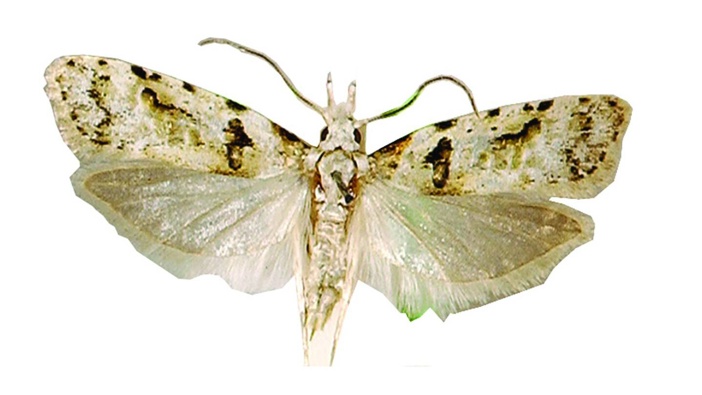Guava Moth
It’s an Aussie moth which arrived in NZ 1997 – probably through wind-dispersal. In Australia its main host is a lillipilly – a member of the Myrtle Family, like Manuka, Pohutukawa/Rata as well as guava and feijoa. It’s not a big deal in Australia (kept in check by predators and parasites) but in NZ feijoa as well as citrus, nashi, macadamia, guavas (and plum, peach, loquats) are the main hosts – they are destructive! They are found Northland down to north Waikato/Coromandel at the moment, and they’re heading South.
Lifecycle takes about 8 weeks “from egg to egg”. These are laid on developing feijoa fruit; young larvae (tiny caterpillars) tunnel into the fruit (pinhole entrance) and eat the flesh. When full-grown the caterpillars come out and bungy-jump down to the soil to pupate. New moths emerge from these pupae, later in the season. They find each other through pheromone (males are very good at that!) they mate, and new eggs are laid.
Main options for control (None of them are very efficient – but it may help):
Cover your feijoas with FINE NETTING so that the female moth can’t lay eggs on the skin of the developing fruit.
HYGIENE: Remove all the fallen fruit ASAP; infected fruit ripen pre-maturely and drop early (danger!!) Don’t compost them unless you’ve frozen the fallen fruit for at least 24 hrs. Otherwise, plastic bag them and into the rubbish or get chickens or pigs to eat them ASAP.
Get a PHEROMONE TRAP (which catches the lusty males) BUT… DON’T RELY On them catching “all” the males – they won’t and you will not find any fewer infected feijoas. The pheromone trap is a TIME INDICATION of when the moths are flying (and hence mating) early in the season. You now know when to put a first spray on the tiny, developing fruit. My guess is to do that about 7-10 days after peak-flight!
SPRAYS: Cover the small fruits with either Success (Yates spray that kills mostly caterpillars, especially the small ones) or Neem Oil; I reckon you may need to do that every 10 to 14 days to be partially successful – further research might tell us how successful that would be.
Finally: there are (solar powered) light traps on the market that employ UV light to attract and catch moths when on the wing. (they drown in water or oil container underneath the trap)
Not happy with that as the by-catch of native moths can be horrendous, especially in summer/autumn. Our native moths (and flies and beetles etc etc) are part of our garden eco-system and are valuable protein for many bird species.
LISTEN TO AUDIO ABOVE
Take your Radio, Podcasts and Music with you










